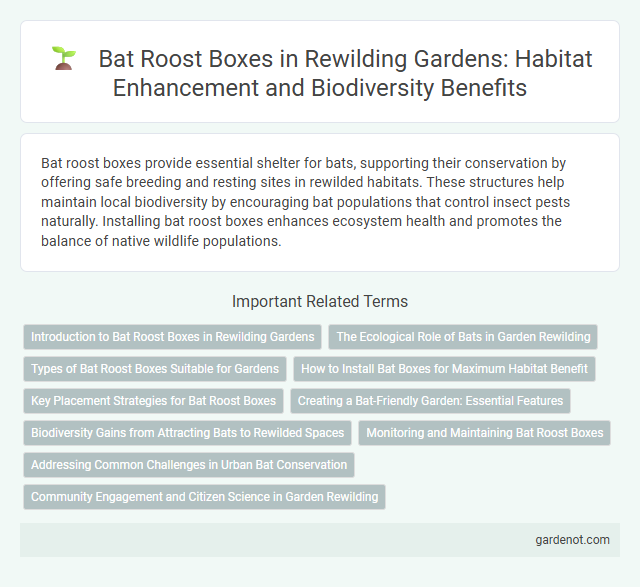Bat roost boxes provide essential shelter for bats, supporting their conservation by offering safe breeding and resting sites in rewilded habitats. These structures help maintain local biodiversity by encouraging bat populations that control insect pests naturally. Installing bat roost boxes enhances ecosystem health and promotes the balance of native wildlife populations.
Introduction to Bat Roost Boxes in Rewilding Gardens
Bat roost boxes provide essential shelter for local bat populations, promoting biodiversity in rewilding gardens. These specialized boxes mimic natural roosting habitats, supporting bat conservation by offering safe breeding and resting sites. Incorporating bat roost boxes enhances nocturnal insect control and strengthens ecosystem balance within urban and rural green spaces.
The Ecological Role of Bats in Garden Rewilding
Bat roost boxes provide essential shelter for bats, supporting their populations in garden rewilding projects by facilitating natural pest control through their predation on nocturnal insects. Bats contribute to maintaining ecological balance by reducing the abundance of agricultural pests, thereby promoting plant health and biodiversity. Installing bat roost boxes enhances habitat connectivity, reinforcing the overall resilience and sustainability of urban and rural ecosystems.
Types of Bat Roost Boxes Suitable for Gardens
Bat roost boxes suitable for gardens include nursery boxes designed for maternity colonies, one-chamber boxes ideal for individual bats or small groups, and multi-chamber boxes which provide more complex habitats supporting diverse bat species. Wooden bat boxes with rough interior surfaces and proper ventilation promote safe roosting and airflow, while durable materials such as cedar or larch resist weathering and predators. Placement height, orientation towards the sun, and proximity to water sources enhance the effectiveness of bat roost boxes in supporting local bat populations and biodiversity.
How to Install Bat Boxes for Maximum Habitat Benefit
Install bat roost boxes at least 10-15 feet above the ground in locations with southern or southeastern exposure to maximize sunlight and warmth. Position boxes away from bright lights and ensure they have rough surfaces or grooves for bats to grip easily. Regularly monitor and maintain the boxes to provide safe, clean habitats that support local bat populations and enhance biodiversity.
Key Placement Strategies for Bat Roost Boxes
Effective bat roost box placement requires selecting sites with minimal light pollution and sheltered from strong winds to mimic natural habitats, enhancing bat occupancy. Positioning boxes 3 to 6 meters above ground on tree trunks or buildings near water sources maximizes access to foraging areas and increases bat activity. Orienting roost entrances away from prevailing winds and toward early morning sun boosts internal temperatures, promoting successful bat colonization and breeding.
Creating a Bat-Friendly Garden: Essential Features
A bat roost box designed for a bat-friendly garden should include weather-resistant materials and a narrow entry slit to provide secure shelter from predators. Installing the box in a quiet, shaded area at a height between 3 to 6 meters enhances bat occupancy and safety. Integrating native plants and water features nearby supports insect populations, creating an ideal foraging environment that promotes local bat biodiversity.
Biodiversity Gains from Attracting Bats to Rewilded Spaces
Bat roost boxes provide essential habitats for various bat species, significantly enhancing biodiversity in rewilded spaces by supporting pollination and insect population control. Attracting bats contributes to ecosystem health by maintaining balanced food webs and promoting seed dispersal, thereby aiding natural regeneration. Installing bat roost boxes encourages the return of native fauna, increasing species richness and ecological resilience in restored environments.
Monitoring and Maintaining Bat Roost Boxes
Monitoring and maintaining bat roost boxes is essential for supporting healthy bat populations and ensuring their long-term habitat stability. Regular inspections help detect damage, remove invasive species, and assess occupancy rates, providing crucial data for conservation efforts. Proper upkeep enhances roost microclimates, promotes bat breeding success, and contributes to biodiversity in rewilding projects.
Addressing Common Challenges in Urban Bat Conservation
Bat roost boxes provide critical shelter for urban bat populations facing habitat loss due to urban development. Strategic placement and design of these boxes address challenges such as limited natural roost sites, exposure to predators, and microclimate regulation. Enhancing urban biodiversity through effective bat conservation supports ecosystem services like insect control and pollination.
Community Engagement and Citizen Science in Garden Rewilding
Bat roost boxes installed in gardens promote community engagement by involving residents in habitat creation and monitoring efforts. Citizen science projects encourage local volunteers to record bat activity, contributing valuable data to conservation databases and enhancing urban biodiversity understanding. These initiatives empower communities to actively participate in rewilding, fostering environmental stewardship and education through hands-on wildlife support.
Bat roost box Infographic

 gardenot.com
gardenot.com